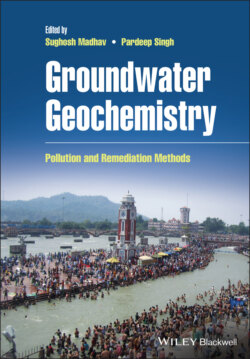Читать книгу Groundwater Geochemistry - Группа авторов - Страница 121
4.6.2 Coagulation‐Flocculation
ОглавлениеThe coagulation and flocculation method has been investigated to eliminate the toxic metal pollution from contaminated water (Abouri et al. 2019; Bora and Dutta 2019). In this process, the coagulant is incorporated into the contaminated water and then forms the floc, which has the potential to eliminate heavy metals from the water. The positively charged coagulants such as aluminium and iron salts, which are widely used for heavy metal like As removal, help to decrease the negative charge of colloids. The larger particles (floc) form due to agglomeration of the particles, which settle down in water due to the influence of gravity (Choong et al. 2007). The formed floc helps to precipitate out the soluble heavy metals from the water and the solution can be filtered rapidly. Several reported coagulants like aluminium, ferrous sulphate, and ferric chloride result in the formation of amorphous metal hydroxide precipitates that are more suitable to eliminate toxic metals from contaminated water (Pallier et al. 2010). At lower pH, the colloidal substances with negative charges can be coagulated, but the cationic ion cannot be eliminated and at higher pH, the turbidity removal decreases and the cationic removal is favoured.
